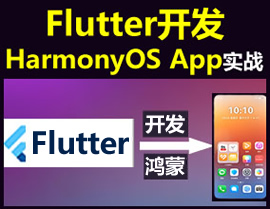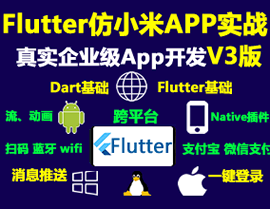Flutter底部导航栏修复插件bottom_bar_fix的使用
Flutter底部导航栏修复插件bottom_bar_fix的使用
在Flutter开发中,底部导航栏是一个非常常见的UI组件。然而,Flutter官方的BottomAppBar只能显示一个带有缺口的浮动操作按钮(FAB),这在某些场景下可能无法满足需求。为了解决这一问题,我们可以使用convex_bottom_bar插件,它提供了多种风格的底部导航栏,并支持自定义主题、动画效果等。
插件简介
convex_bottom_bar 是一个功能强大的底部导航栏插件,灵感来源于 BottomAppBar 和 NotchShape 的实现。它允许开发者创建更复杂的凸起形状和自定义样式。
功能特点:
- 提供多种内置样式。
- 支持更改
AppBar的主题。 - 提供构建器 API,可以自定义新的样式。
- 可以在标签菜单上添加徽章。
- 拥有优雅的过渡动画。
- 提供钩子 API 来覆盖部分内部样式。
- 支持 RTL(从右到左)布局。
如何使用
要开始使用 convex_bottom_bar 插件,首先需要将其添加到项目的依赖中。
1. 添加依赖
在 pubspec.yaml 文件中添加以下内容:
dependencies:
convex_bottom_bar: ^最新版本号然后运行 flutter pub get 安装依赖。
2. 基本用法
ConvexAppBar 可以通过设置 Scaffold 的 bottomNavigationBar 属性来使用。它有两个构造函数:ConvexAppBar() 和 ConvexAppBar.builder()。其中,ConvexAppBar() 使用默认样式简化了选项卡的创建。
示例代码:
import 'package:flutter/material.dart';
import 'package:convex_bottom_bar/bottom_bar_fix.dart';
void main() => runApp(MyApp());
class MyApp extends StatelessWidget {
[@override](/user/override)
Widget build(BuildContext context) {
return MaterialApp(
home: MyHomePage(),
);
}
}
class MyHomePage extends StatelessWidget {
[@override](/user/override)
Widget build(BuildContext context) {
return Scaffold(
appBar: AppBar(
title: Text('ConvexAppBar 示例'),
),
body: Center(
child: Text('点击导航栏切换页面'),
),
bottomNavigationBar: ConvexAppBar(
items: [
TabItem(icon: Icons.home, title: '首页'),
TabItem(icon: Icons.search, title: '搜索'),
TabItem(icon: Icons.add, title: '发布'),
TabItem(icon: Icons.chat, title: '消息'),
TabItem(icon: Icons.person, title: '我的'),
],
initialActiveIndex: 2, // 默认选中的索引
onTap: (int index) => print('点击了第 $index 个选项'),
),
);
}
}效果图:

自定义样式
如果默认样式不符合需求,可以通过 builder 方法来自定义每个选项卡的外观。
示例代码:
import 'package:flutter/material.dart';
import 'package:convex_bottom_bar/bottom_bar_fix.dart';
void main() => runApp(MyApp());
class MyApp extends StatelessWidget {
[@override](/user/override)
Widget build(BuildContext context) {
return MaterialApp(
home: MyHomePage(),
);
}
}
class MyHomePage extends StatelessWidget {
[@override](/user/override)
Widget build(BuildContext context) {
return Scaffold(
appBar: AppBar(
title: Text('自定义导航栏'),
),
body: Center(
child: Text('自定义选项卡样式'),
),
bottomNavigationBar: ConvexAppBar.builder(
count: 5, // 总共有5个选项卡
backgroundColor: Colors.blue,
style: TabStyle.fixed, // 固定风格
itemBuilder: (context, index, active) {
return Text(
'Tab $index',
style: TextStyle(
fontSize: active ? 18 : 16,
fontWeight: active ? FontWeight.bold : FontWeight.normal,
),
);
},
),
);
}
}添加徽章
如果需要在选项卡上显示徽章(如未读消息数量),可以使用 ConvexAppBar.badge() 方法。
示例代码:
import 'package:flutter/material.dart';
import 'package:convex_bottom_bar/bottom_bar_fix.dart';
void main() => runApp(MyApp());
class MyApp extends StatelessWidget {
[@override](/user/override)
Widget build(BuildContext context) {
return MaterialApp(
home: MyHomePage(),
);
}
}
class MyHomePage extends StatelessWidget {
[@override](/user/override)
Widget build(BuildContext context) {
return Scaffold(
appBar: AppBar(
title: Text('带徽章的导航栏'),
),
body: Center(
child: Text('徽章示例'),
),
bottomNavigationBar: ConvexAppBar.badge(
{0: '99+', 1: Icons.notifications, 2: Colors.redAccent}, // 徽章数据
items: [
TabItem(icon: Icons.home, title: '首页'),
TabItem(icon: Icons.chat, title: '消息'),
TabItem(icon: Icons.settings, title: '设置'),
],
onTap: (int index) => print('点击了第 $index 个选项'),
),
);
}
}RTL 支持
convex_bottom_bar 插件原生支持 RTL(从右到左)布局。只需在应用中设置 TextDirection 即可。
示例代码:
import 'package:flutter/material.dart';
import 'package:convex_bottom_bar/bottom_bar_fix.dart';
void main() => runApp(MyApp());
class MyApp extends StatelessWidget {
[@override](/user/override)
Widget build(BuildContext context) {
return MaterialApp(
home: Directionality(
textDirection: TextDirection.rtl,
child: Scaffold(
appBar: AppBar(
title: Text('RTL 导航栏'),
),
body: Center(
child: Text('RTL 示例'),
),
bottomNavigationBar: ConvexAppBar(
items: [
TabItem(icon: Icons.home, title: '主页'),
TabItem(icon: Icons.search, title: '搜索'),
],
initialActiveIndex: 0,
onTap: (int index) => print('点击了第 $index 个选项'),
),
),
),
);
}
}更多关于Flutter底部导航栏修复插件bottom_bar_fix的使用的实战系列教程也可以访问 https://www.itying.com/category-92-b0.html
bottom_bar_fix 是一个用于修复 Flutter 底部导航栏(Bottom Navigation Bar)常见问题的插件。它可以解决在切换页面时重新渲染底部导航栏的问题,提升用户体验。下面是如何使用 bottom_bar_fix 插件的详细步骤。
1. 添加依赖
首先,你需要在 pubspec.yaml 文件中添加 bottom_bar_fix 插件的依赖:
dependencies:
flutter:
sdk: flutter
bottom_bar_fix: ^1.0.0 # 请使用最新版本然后运行 flutter pub get 来安装依赖。
2. 导入插件
在你的 Dart 文件中导入 bottom_bar_fix 插件:
import 'package:bottom_bar_fix/bottom_bar_fix.dart';3. 创建底部导航栏
使用 BottomBarFix 组件来创建底部导航栏。你可以通过 items 属性来定义导航栏的各个项目,并通过 onTap 来处理用户点击事件。
class MyHomePage extends StatefulWidget {
@override
_MyHomePageState createState() => _MyHomePageState();
}
class _MyHomePageState extends State<MyHomePage> {
int _currentIndex = 0;
final List<Widget> _pages = [
Page1(),
Page2(),
Page3(),
];
@override
Widget build(BuildContext context) {
return Scaffold(
body: _pages[_currentIndex],
bottomNavigationBar: BottomBarFix(
items: const <BottomBarFixItem>[
BottomBarFixItem(
icon: Icon(Icons.home),
title: Text('Home'),
),
BottomBarFixItem(
icon: Icon(Icons.business),
title: Text('Business'),
),
BottomBarFixItem(
icon: Icon(Icons.school),
title: Text('School'),
),
],
currentIndex: _currentIndex,
onTap: (int index) {
setState(() {
_currentIndex = index;
});
},
),
);
}
}4. 定义页面
在上面的代码中,_pages 是一个包含不同页面的列表。你需要定义这些页面:
class Page1 extends StatelessWidget {
@override
Widget build(BuildContext context) {
return Center(
child: Text('Home Page'),
);
}
}
class Page2 extends StatelessWidget {
@override
Widget build(BuildContext context) {
return Center(
child: Text('Business Page'),
);
}
}
class Page3 extends StatelessWidget {
@override
Widget build(BuildContext context) {
return Center(
child: Text('School Page'),
);
}
}5. 运行应用
现在你可以运行你的 Flutter 应用,底部导航栏应该能够正常工作,并且在切换页面时不会重新渲染。
6. 自定义样式
你可以通过 BottomBarFix 的其他属性来自定义底部导航栏的样式,例如 backgroundColor、selectedItemColor、unselectedItemColor 等。
bottomNavigationBar: BottomBarFix(
items: const <BottomBarFixItem>[
BottomBarFixItem(
icon: Icon(Icons.home),
title: Text('Home'),
),
BottomBarFixItem(
icon: Icon(Icons.business),
title: Text('Business'),
),
BottomBarFixItem(
icon: Icon(Icons.school),
title: Text('School'),
),
],
currentIndex: _currentIndex,
onTap: (int index) {
setState(() {
_currentIndex = index;
});
},
backgroundColor: Colors.blue,
selectedItemColor: Colors.white,
unselectedItemColor: Colors.grey,
),






